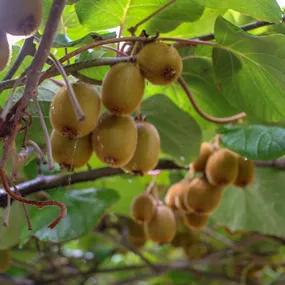Jenny Kiwi Fruit Vines
The details
Actinidia deliciosa
- Eating.
- Self Fertile.
- Crops in Late Aug/Sept
- Ripens off the tree.
- Year Round Delivery
Recommended extras
Description
Actinidia deliciosa 'Jenny' Potgrown Kiwi Plants
Jenny is a sweet, hairy kiwi vine that grows well in sheltered, sunny sites across most of England and Wales. Gardeners in the North and Scotland can grow them in a greenhouse.
The lush green leaves have red stalks and will cover up a wall or fence as well as any ornamental climbing plant. Jenny is a self fertile Kiwi, so you only need one plant.
Jenny is a big vine, so not really suited to most small gardens.
Kiwis are one of our exotic fruit varieties; browse all our fruit trees.
Features
- Eating.
- Self Fertile.
- Climbing plant: needs strong supports.
- Very vigorous to 6m x 3m
- Diseases: Plants in greenhouses should be checked for red spider mites.
- Harvest: Pick the fruit just as their colour turns from green to brown. They will then ripen fully off the tree.
Growing Jenny Kiwis
Kiwis are vines that need to be grown up or over supports, usually on wires or a trellis. The south facing wall of a house is ideal.
We don't want to put you off growing your own Kiwis. They are quite hardy, and grow happily in the open as far North as Yorkshire, and under glass anywhere in Britain.
With that said, your crops need a long, sunny summer to be at their best. You will always get more reliable results if you grow your vines under glass or in a poly-tunnel.
The flowers are sensitive to late spring frosts but, in most years, your vines should not come into flower until the frosts have passed. It is recommended to cover your plants for the night if there is a frost warning when they are in flower.
Rich soil is important, so take the time to prepare the site well and dig in plenty of garden manure and compost before planting. If you have sandy, poorly fertile soil, dig a bigger hole and mix in more organic material.
Soil drainage must be good and a South facing site with full sun is necessary for good cropping.
Keep the root area mulched to preserve soil moisture. When your plants are three years old, begin to feed them when they show signs of growth in spring, and stop when the fruit are get big. Young plants require only a little feeding, while mature plants over five or six years old need a good dose of nitrogen over the growing season: formulas for citrus plants and avocados are suitable for kiwi, but general purpose liquid feed is fine.
The day before you apply fertiliser, water the vines well, then water them as you apply the feed, and water them the next day as well.
Thinning your Fruit: If you are growing your vines in the open and summer is turning out to be cloudy and cool, you can greatly improve the quality of your fruit by removing about a third to a half of the developing crop. It's better to have a small crop of delicious, sweet Kiwis than a big crop of unsatisfactory fruit.
If weather conditions are good, then only remove the smallest fruit, misshaped ones, or to reduce the size of the biggest groups of fruit.
Pruning Kiwi Vines:
Kiwis are vigorous, and will get very big if you allow them to. The rule with Kiwi vines is to cut each individual stem down to the ground when it reaches three to four years old. Kiwis mainly carry fruit on new shoots that come off one and two-year-old vines. By removing the older vines, you will keep the size of your plant under control, and ensure that most of the stems are less than 4 years old and cropping well.
You should start pruning your plants about 2 years after you plant them. It is best to prune them in winter.
Remember to Remove Root Suckers!
Like most fruit plants, your vines are grafted onto a rootstock, which means that the roots are a different plant to the one you see above ground.
Root suckers are shoots from the rootstock that appear from below the joint where the two plants are grafted together.
You must cut these down to the root on sight - ideally catch them young and rip them off, which is better for discouraging future suckers.


